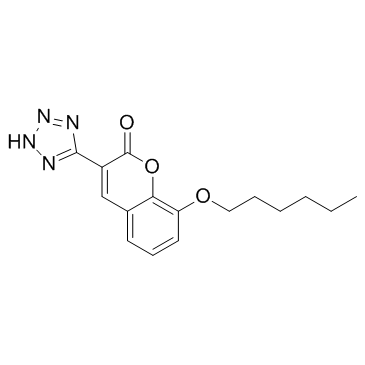| Description |
KP136 is an orally effective antiallergic agent. The IC50 is 76.1 μg/mL for histamine release and 63 ug/mL for degranulation.
|
| Related Catalog |
|
| Target |
Histamine release[1]
|
| In Vitro |
KP136 (0.01 μg/mL) inhibits this histamine release and degranulation in a dose-dependent manner, confirming that it is an inhibitor of mast cell activation. The IC50 is 76.1 μg/mL for histamine release and 63 ug/mL for degranulation[1].
|
| In Vivo |
C4C at 0.2 mg/kg produces an equipotent effect to 1 mg/kg KP136 (KP-136) or 5 mg/kg DSCG. However, C4C is less effective by the oral route because it only produces a maximum inhibition of about 35% even at the high dose of 100 mg/kg, whereas KP136 shows an overt inhibitory effect of about 66% at the oral dose of 2 mg/kg. On the other hand, KP136 (1 mg/kg, i.v.) also remarkably inhibits 5-h homologous PCA, having an activity similar to that of C4C[1].
|
| Kinase Assay |
The sensitized peritoneal exudate cells are taken from rats weighing 140-180 g with a 24-hr latent period, into which anti-DNP-As serum (0.1 mL) is injected in traperitoneally and suspended at a density of 5×104 mast cells/mL in PBS, pH 7.2 [137 mM NaCl, 2.7 mM KCl, 1 mM CaCl2, 1 mM MgCl2 6H20, 5.6 mM glucose and 5% (v/v) of 0.1 M phosphate buffer]. For histamine release assay, 2.5 mL of the cell suspension are mixed with 0.5 mL of PBS containing a test compound and DNP-As. The mixture is incubated at 37°C for 10 min and centrifuged at 670× g for 10 min. The histamine contents of the precipitate and the supernatant are measured by the fluorometric method. The mast cell degranulaton assay is carried out. The sensitized cell suspension (50 μL) is mixed with 50 μL of PBS containing a test compound and DNP-As in a Bellco micro-slide culture chamber. The chamber is incubated at 37°C for 10 min, and the cells on microscope slides are fixed and stained by the addition (100 μL/chamber) of 20% neutral formalin solution containing 0.2% toluidine blue. The proportion of mast cells undergoing degranulation is assessed for about 200 mast cells under microscopic observation[1].
|
| Animal Admin |
Pigs[1] The trachea is taken from male guinea pigs, weighing 500-590 g, that are sacrificed by bleeding and then cut into 1.5 mm wide to make tracheal rings. Five specimens are tied at cartilage sites crossing each smooth muscle layer. This preparation is incubated in Tyrode's solution at 37°C, which is bubbled with 95% O2/5% CO2. The tension change of the tracheal muscle preparation is recorded through an isotonic transducer. C4C and KP136 in 0.5% KHCO3 or isoproterenol in saline is added cumulatively to the Tyrode's solution at a 1/200 volume. Relaxation percentage is calculated from the maximum relaxation value (100%) produces by re placement of the bathing medium with Tyrode's solution containing no CaCl2.
|
| References |
[1]. Kuriyama K, et al. Antiallergic effects of 4-[2-oxo-3-(1H-tetrazol-5-yl)-2H-chromen-8-yloxy]-bu tyric acid. Jpn J Pharmacol. 1989 Jun;50(2):111-8.
|
